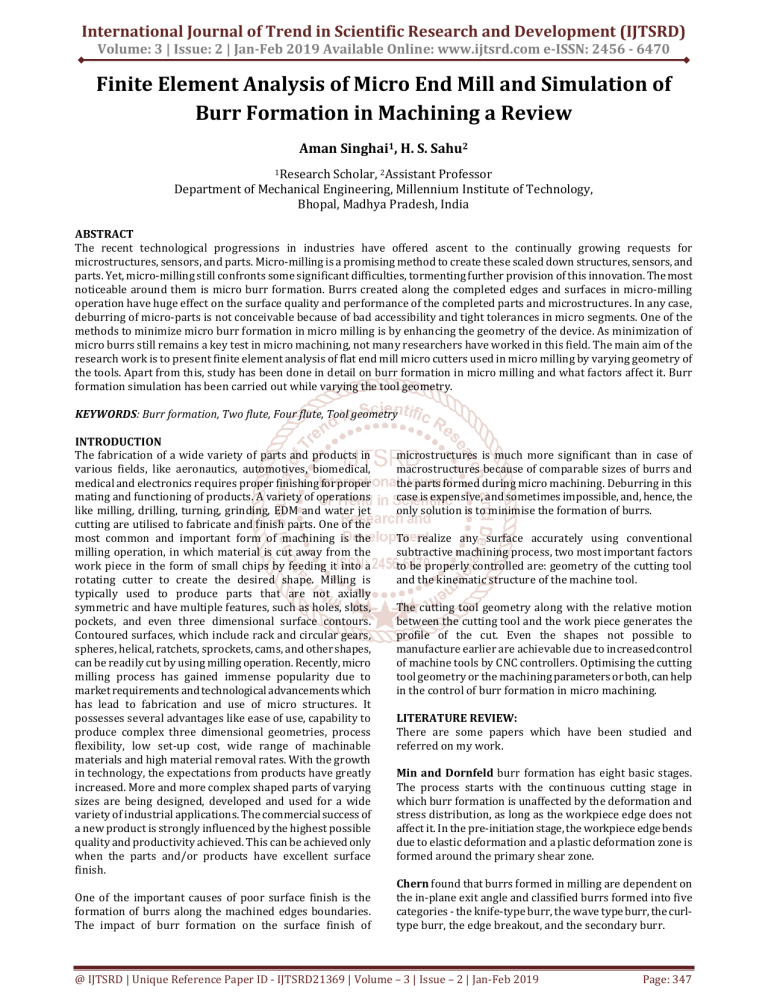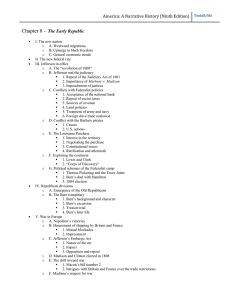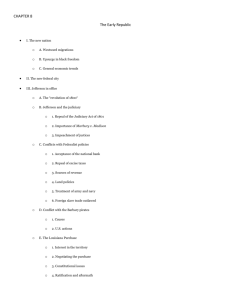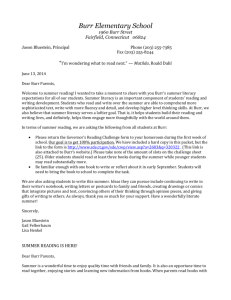
International Journal of Trend in Scientific Research and Development (IJTSRD)
Volume: 3 | Issue: 2 | Jan-Feb 2019 Available Online: www.ijtsrd.com e-ISSN: 2456 - 6470
Finite Element Analysis of Micro End Mill and Simulation of
Burr Formation in Machining a Review
Aman Singhai1, H. S. Sahu2
1Research
Scholar, 2Assistant Professor
Department of Mechanical Engineering, Millennium Institute of Technology,
Bhopal, Madhya Pradesh, India
ABSTRACT
The recent technological progressions in industries have offered ascent to the continually growing requests for
microstructures, sensors, and parts. Micro-milling is a promising method to create these scaled down structures, sensors, and
parts. Yet, micro-milling still confronts some significant difficulties, tormenting further provision of this innovation. The most
noticeable around them is micro burr formation. Burrs created along the completed edges and surfaces in micro-milling
operation have huge effect on the surface quality and performance of the completed parts and microstructures. In any case,
deburring of micro-parts is not conceivable because of bad accessibility and tight tolerances in micro segments. One of the
methods to minimize micro burr formation in micro milling is by enhancing the geometry of the device. As minimization of
micro burrs still remains a key test in micro machining, not many researchers have worked in this field. The main aim of the
research work is to present finite element analysis of flat end mill micro cutters used in micro milling by varying geometry of
the tools. Apart from this, study has been done in detail on burr formation in micro milling and what factors affect it. Burr
formation simulation has been carried out while varying the tool geometry.
KEYWORDS: Burr formation, Two flute, Four flute, Tool geometry
INTRODUCTION
The fabrication of a wide variety of parts and products in
various fields, like aeronautics, automotives, biomedical,
medical and electronics requires proper finishing for proper
mating and functioning of products. A variety of operations
like milling, drilling, turning, grinding, EDM and water jet
cutting are utilised to fabricate and finish parts. One of the
most common and important form of machining is the
milling operation, in which material is cut away from the
work piece in the form of small chips by feeding it into a
rotating cutter to create the desired shape. Milling is
typically used to produce parts that are not axially
symmetric and have multiple features, such as holes, slots,
pockets, and even three dimensional surface contours.
Contoured surfaces, which include rack and circular gears,
spheres, helical, ratchets, sprockets, cams, and other shapes,
can be readily cut by using milling operation. Recently, micro
milling process has gained immense popularity due to
market requirements and technological advancements which
has lead to fabrication and use of micro structures. It
possesses several advantages like ease of use, capability to
produce complex three dimensional geometries, process
flexibility, low set-up cost, wide range of machinable
materials and high material removal rates. With the growth
in technology, the expectations from products have greatly
increased. More and more complex shaped parts of varying
sizes are being designed, developed and used for a wide
variety of industrial applications. The commercial success of
a new product is strongly influenced by the highest possible
quality and productivity achieved. This can be achieved only
when the parts and/or products have excellent surface
finish.
One of the important causes of poor surface finish is the
formation of burrs along the machined edges boundaries.
The impact of burr formation on the surface finish of
microstructures is much more significant than in case of
macrostructures because of comparable sizes of burrs and
the parts formed during micro machining. Deburring in this
case is expensive, and sometimes impossible, and, hence, the
only solution is to minimise the formation of burrs.
To realize any surface accurately using conventional
subtractive machining process, two most important factors
to be properly controlled are: geometry of the cutting tool
and the kinematic structure of the machine tool.
The cutting tool geometry along with the relative motion
between the cutting tool and the work piece generates the
profile of the cut. Even the shapes not possible to
manufacture earlier are achievable due to increasedcontrol
of machine tools by CNC controllers. Optimising the cutting
tool geometry or the machining parameters or both, can help
in the control of burr formation in micro machining.
LITERATURE REVIEW:
There are some papers which have been studied and
referred on my work.
Min and Dornfeld burr formation has eight basic stages.
The process starts with the continuous cutting stage in
which burr formation is unaffected by the deformation and
stress distribution, as long as the workpiece edge does not
affect it. In the pre-initiation stage, the workpiece edge bends
due to elastic deformation and a plastic deformation zone is
formed around the primary shear zone.
Chern found that burrs formed in milling are dependent on
the in-plane exit angle and classified burrs formed into five
categories - the knife-type burr, the wave type burr, the curltype burr, the edge breakout, and the secondary burr.
@ IJTSRD | Unique Reference Paper ID - IJTSRD21369 | Volume – 3 | Issue – 2 | Jan-Feb 2019
Page: 347
International Journal of Trend in Scientific Research and Development (IJTSRD) @ www.ijtsrd.com eISSN: 2456-6470
Gillespie classified four types of burrs based on formation
mechanism - Tear, Rollover, Poisson and Cut-off burrs. A tear
burr is the consequence of material tearing detached from
the workpiece as opposed to shearing. The rollover burr is
basically a chip that is bowed as opposed to sheared,
bringing about a nearly bigger burr. This kind of burr is
otherwise called a passageway burr in light of the fact that it
is typically framed at the end of a cut in face-processing. The
Poisson burr is an aftereffect of a material's tendency to
lump at the sides when it is compacted until perpetual
plastic deformation happens. It is like the burr shaped in
punching operations. The cut-off burr is the consequence of
workpiece partition from the crude material before the
detachment cut is done.
Lee et al. In traditional courses of action, these top or
entrance type burrs are generously more diminutive than
exit type burrs, and typically no deburring procedure is
important. Then again, micro-top or entrance type burrs are
large comparatively in light of the fact that the cutting edge
radius is substantially large as compared to the feed per
tooth.
Li et al. The tools can even break if the cutting conditions are
not chosen likewise. Subsequently, an exact estimation of the
cutting powers of micro-end-milling assumes an essential
part in controlling the determination of cutting conditions
with a specific end goal to monetarily acquire high
machining quality and guarantee as long an tool life as could
be expected under the circumstances. At micro level, we
can't accept that edge radius has unimportant impacts on
cutting powers.
Weuleet al discovered that the roundness of a forefront is
more critical at micro scale machining. As the span of an
instrument decreases, the sharpness of the gadget can't be
upgraded moderately due to stipulations in the mechanical
assembly creation strategies and reduction in the structural
nature of the instrument. Along these lines, the feed per
tooth in micro-processing may be for all intents and purpose
indistinguishable.
Kimet al tentatively confirmed that when the feed per tooth
is practically identical with the edge radius of the apparatus,
as is frequently the case in micro-milling courses of action,
the chip shaping methodology gets discontinuous and the
accepted comprehension that a chip is framed with each
tooth pass is no more legitimate. As indicated by their model,
the base chip thickness of different consolidations of devices
and work piece materials may be evaluated focused around
effortlessly achievable cutting force information.
METHOD USED
The investigation of the progress of cutting forces in any
machining methodology is profoundly key for fitting,
arranging and control of machining process and for the
enhancement of the cutting conditions to minimize
production expenses and times. Cutting force analysis
assumes an imperative part in study of the different qualities
of a machining process, viz. the dynamic stability, situating
precision of the instrument as for the work piece, harshness
of the machined surface and structure mistakes of the
machined component, and so on.
In most micro-end-processing operations, the micro cutting
device measurement differs from 0.1 mm to 1 mm, and
anxiety variety on the modest shaft of the micro cutting
apparatus is much higher than that on an expected scale
instrument, which definitely abbreviates the instrument's
life. The tools can even break if the cutting conditions are not
chosen likewise. Subsequently, an exact estimation of the
cutting powers of micro-end-milling assumes an essential
part in controlling the determination of cutting conditions
with a specific end goal to monetarily acquire high
machining quality and guarantee as long an tool life as could
be expected under the circumstances. The roundness of a
forefront is more critical at micro scale machining. As the
span of an instrument decreases, the sharpness of the gadget
can't be upgraded moderately due to stipulations in the
mechanical assembly creation strategies and reduction in the
structural nature of the instrument. Along these lines, the
feed per tooth in micro-processing may be for all intents and
purpose indistinguishable.
CONCLUSIONS
This thesis may concludes the technical sum-up of the thesis
work on three-dimensional geometric modeling and analysis
of micro end milling cutters and simulation of micro burrs
formed during micro milling of Al6061-T6 alloy by using a
tungsten carbide two flute micro end mill cutter. This is
followed by directions for future work.
Burr formation is a major hindrance to good surface finish in
case of both macro and micro milling. However, burr
formation in case of micro milling is of greater importance
than in case of conventional milling as burrs formed in the
former case are of sub-micrometer size and deburring
processes are expensive, and sometimes impossible. Hence,
burr minimization is the only way of obtaining good surface
finish in microstructures.To minimize formation of burrs in
case of micro milling, either the cutting conditions or the tool
geometry can be optimized. In this work, tool geometry
optimization has been tried to be achieved by performing FE
analysis on tools with different sets of rake and relief angles,
for both two flute and four flute micro end mills.
REFERENCES
[1] Afazov, S.M., Ratchev, S.M. and Segal, J., Modelling and
simulation of micro-milling cutting forces, Journal of
Materials Processing Technology, Vol.210, pp. 21542162 (2010).
[2] Alrabii SA, An experimental study of burr formation in
drilling and slot-end milling operations, Journal of
Engineering, 15(4) (2009) 4219- 4240.
[3] Ávila M, Gardner J, Reich-Weiser C, Tripathi S,
Vijayaraghavan A, Dornfeld D. Strategies for Burr
Minimization and Cleanability in Aerospace and
Automotive Manufacturing. SAE Transactions Journal
of Aerospace, 114 (1), pp. 1073-1082 (2006).
[4] Aziz M, Ohnishi O, Onikura H, Innovative micro hole
machining with minimum burr formation by the use of
newly developed micro compound tool, Journal of
Manufacturing Processes, 14 (2012) 224–232.
[5] Bao WY, Tansel IN, Modeling micro-end-milling
operations. Part I: analytical cutting force model,
International Journal of Machine Tools & Manufacture,
40 (2000) 2155-2173.
@ IJTSRD | Unique Reference Paper ID - IJTSRD21369 | Volume – 3 | Issue – 2 | Jan-Feb 2019
Page: 348
International Journal of Trend in Scientific Research and Development (IJTSRD) @ www.ijtsrd.com eISSN: 2456-6470
[6] Bao WY, Tansel IN, Modeling micro-end-milling
operations. Part II: tool run-out, International Journal
of Machine Tools & Manufacture, 40 (2000) 2175–
2192.
[7] Chang SSF, Bone GM, Burr height model for vibration
assisted drilling of aluminum 6061-T6, Precision
Engineering, 34 (2010) 369–375.
[8] Chen MJ, Ni HB, Wang ZJ, Jiang Y, Research on the
modeling of burr formation process in micro-ball end
milling operation on Ti–6Al–4V, International Journal
of Advanced Manufacturing Technology, 62 (2012)
901–912.
[9] Chern GL, Analysis of Burr Formation and Breakout in
Metal Cutting, Ph.D. Thesis, University of California at
Berkeley, Berkeley, CA, (1993).
@ IJTSRD | Unique Reference Paper ID - IJTSRD21369 | Volume – 3 | Issue – 2 | Jan-Feb 2019
Page: 349





